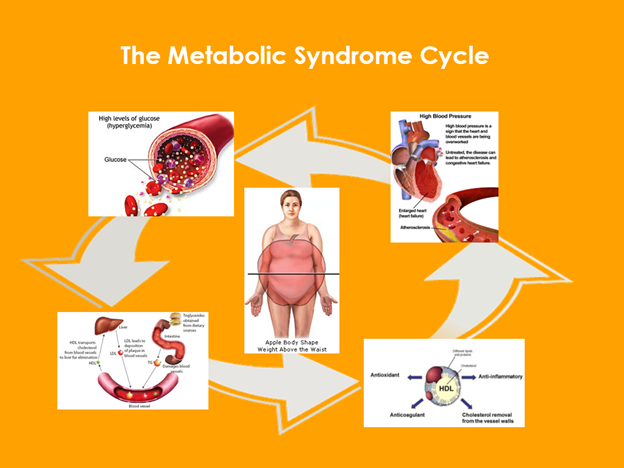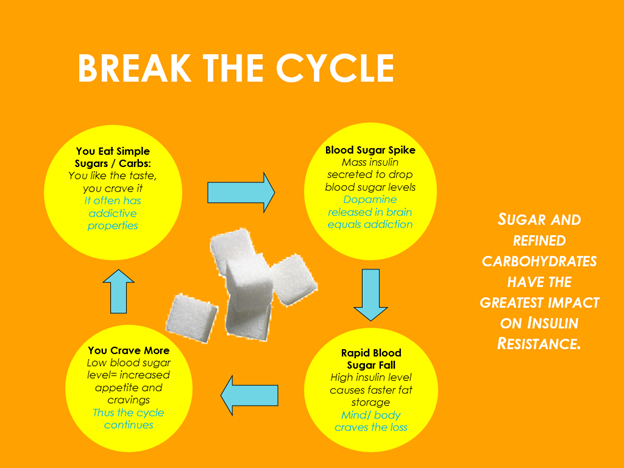Metabolic Syndrome: Change Your Lifestyle, Change Your Risk

4 min read
A person is diagnosed with metabolic syndrome when they have three or more of the following five risk factors:
 The increased insulin raises triglyceride levels, decreases HDLs (good cholesterol) and leads to elevated blood pressure. A person with metabolic syndrome can have nearly double the risk of congestive heart failure as a person without these cluster of risks.
The increased insulin raises triglyceride levels, decreases HDLs (good cholesterol) and leads to elevated blood pressure. A person with metabolic syndrome can have nearly double the risk of congestive heart failure as a person without these cluster of risks.
The goal of metabolic syndrome treatment is to reduce the risk of heart disease and diabetes by controlling the associated risks. The good news is that there are several solutions to combat metabolic syndrome and reduce your long-term risk. You can take back control with lifestyle changes.
The priority should be to address the underlying problem: obesity and lack of physical activity. Weight loss of 5-10% of body weight in insulin resistant individuals will significantly enhance insulin sensitivity. Weight loss should be gradual and achieved in a healthy way. Strict or fad dieting can be a mistake when trying to change your health status. Focus more on the food you can and should eat:
Focus more on the food you can and should eat:
Foods to Avoid or Reduce:
Exercise improves cardiovascular fitness, weight control, sensitivity to insulin, reduces incidence of diabetes, and can improve sleep patterns. Exercise leads to weight loss while also improving cholesterol levels and insulin sensitivity. Exercise has been proven to improve blood pressure levels and reduce incidence of diabetes.
Keep it simple and be sure to check with your doctor before starting any new exercise program. A great goal to begin with is brisk walking for 30 minutes each day. This can be done in two to three sessions broken up throughout the day.
Medication Treatment for Individual Risks and Tobacco Use
Even with weight loss and dietary changes, the individual risks contributing to metabolic disease may need to be addressed. It is important to work closely with your doctor. Medications to treat risk factors may be necessary. Be sure to take all medications responsibly.
If you smoke or use tobacco, consider quitting. Tobacco use is not considered a metabolic syndrome risk factor but does have indirect risk. Smokers are at increased risk of developing type 2 diabetes and cardiovascular disease. Quitting can have a significant impact on lowering your long-term risk for metabolic syndrome as well as numerous other illnesses and diseases.
Lifestyle and behavior change is the main takeaway here. Even with the best physicians and medications to treat these individual risk factors, prevention and treatment of metabolic syndrome can only be achieved with changes to dietary habits and an increase in physical activity levels.
- High Blood Pressure
- Low HDL or Good Cholesterol Level
- At Risk Triglyceride Level
- Elevated Blood Glucose
- At Risk Waist Circumference
Metabolic syndrome can lead to greater life-threatening issues.
Nearly one in three of U.S. adults are affected by metabolic syndrome and prevalence is higher in those over the age of 50. Metabolic syndrome is primarily caused by obesity and inactivity and is linked to insulin resistance. The body reacts by producing more insulin. This excess insulin may not be high enough to qualify as diabetes, but elevated blood glucose still interferes with the body’s processes. The most common causes of insulin resistance are excessive amount of fat, specifically visceral fat, inactivity, and genetic predisposition. To better understand it, think of metabolic syndrome as more of a cycle: obesity leads to insulin resistance which can lead to metabolic syndrome which then can lead to diabetes and heart disease. The increased insulin raises triglyceride levels, decreases HDLs (good cholesterol) and leads to elevated blood pressure. A person with metabolic syndrome can have nearly double the risk of congestive heart failure as a person without these cluster of risks.
The increased insulin raises triglyceride levels, decreases HDLs (good cholesterol) and leads to elevated blood pressure. A person with metabolic syndrome can have nearly double the risk of congestive heart failure as a person without these cluster of risks.
Preventing and Managing Metabolic Syndrome
If you have metabolic syndrome or think you are at risk, consider this your wake-up call. Use it as a strong motivator to make the behavioral changes you need to make an impact on your overall health status.The goal of metabolic syndrome treatment is to reduce the risk of heart disease and diabetes by controlling the associated risks. The good news is that there are several solutions to combat metabolic syndrome and reduce your long-term risk. You can take back control with lifestyle changes.
The priority should be to address the underlying problem: obesity and lack of physical activity. Weight loss of 5-10% of body weight in insulin resistant individuals will significantly enhance insulin sensitivity. Weight loss should be gradual and achieved in a healthy way. Strict or fad dieting can be a mistake when trying to change your health status.
Breaking the Cycle of Metabolic Syndrome
The key dietary change you should begin with is to limit your refined carbohydrates and processed foods. Eating these foods is part of what contributes to the viscous cycle of metabolic disease: Focus more on the food you can and should eat:
Focus more on the food you can and should eat:
- Non-Starchy Vegetables
- Fresh Fruit
- Preservative Free Meats*
- Chicken and Poultry*
- Fish and Seafood*
- Eggs
- Nuts and Seeds
- Plain Yogurt
- Olive Oil, Coconut Oil (In Small Portions)
- High Fiber Foods
- Beans
- Water
- Unsweetened Herbal Tea
Foods to Avoid or Reduce:
- Soft Drinks and Sweetened Beverages
- Added Sugars
- Processed Foods (Baked Goods, Desserts, Sweets)
- Artificial Sweeteners
- Fast and Fried Food
- Enriched/ Refined Breads and Pasta
- Margarine and Trans Fats
Exercise improves cardiovascular fitness, weight control, sensitivity to insulin, reduces incidence of diabetes, and can improve sleep patterns. Exercise leads to weight loss while also improving cholesterol levels and insulin sensitivity. Exercise has been proven to improve blood pressure levels and reduce incidence of diabetes.
Keep it simple and be sure to check with your doctor before starting any new exercise program. A great goal to begin with is brisk walking for 30 minutes each day. This can be done in two to three sessions broken up throughout the day.
Medication Treatment for Individual Risks and Tobacco Use
Even with weight loss and dietary changes, the individual risks contributing to metabolic disease may need to be addressed. It is important to work closely with your doctor. Medications to treat risk factors may be necessary. Be sure to take all medications responsibly.
If you smoke or use tobacco, consider quitting. Tobacco use is not considered a metabolic syndrome risk factor but does have indirect risk. Smokers are at increased risk of developing type 2 diabetes and cardiovascular disease. Quitting can have a significant impact on lowering your long-term risk for metabolic syndrome as well as numerous other illnesses and diseases.
Lifestyle and behavior change is the main takeaway here. Even with the best physicians and medications to treat these individual risk factors, prevention and treatment of metabolic syndrome can only be achieved with changes to dietary habits and an increase in physical activity levels.

